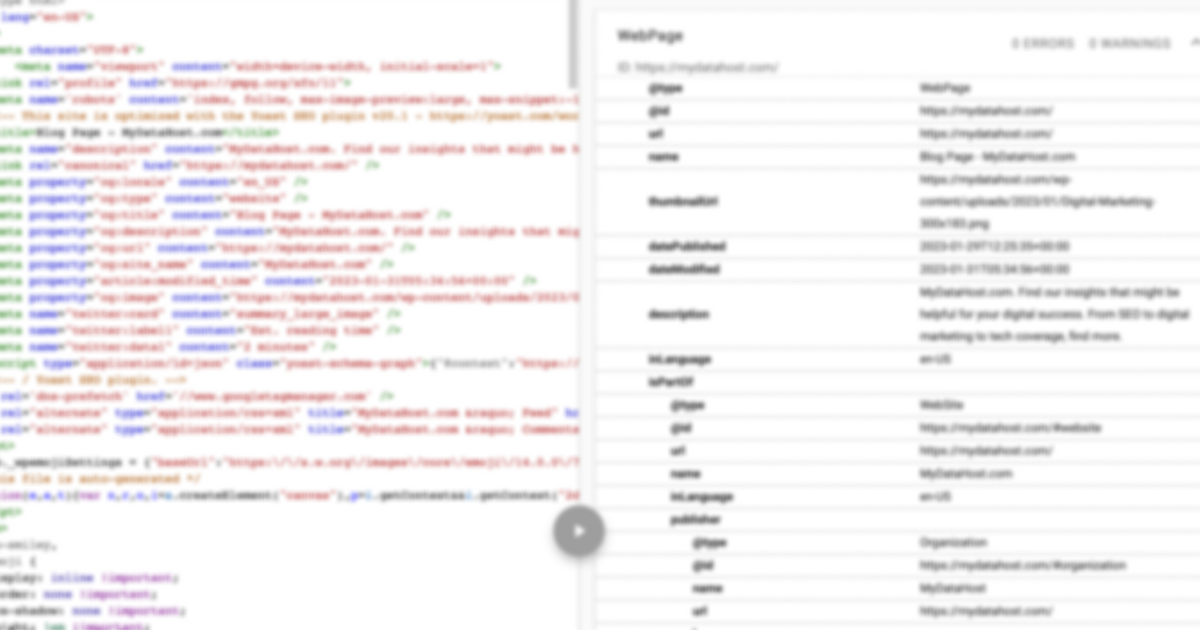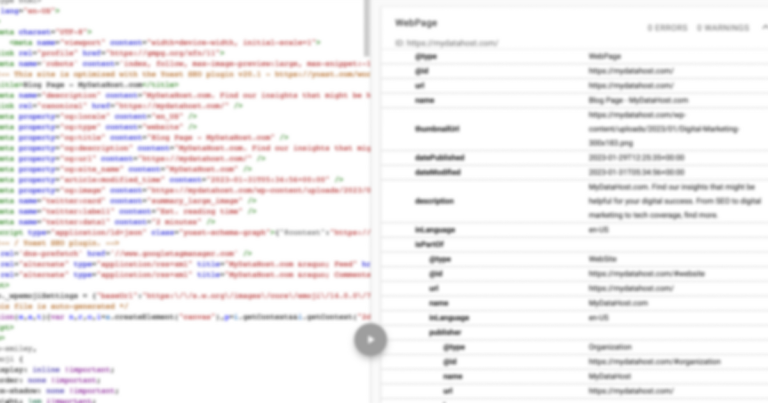As search engines continue to evolve, structured data markup has become an important component of technical SEO. Structured data markup is a way of providing search engines with more detailed information about your website’s content, which can help them better understand and index your site.
In this guide, we’ll provide an overview of structured data markup and show you how to implement it on your website.
What is Structured Data Markup?
Structured data markup is a set of code that helps search engines better understand the content on your website. This code is added to your HTML and provides information about the content on your site, including things like the author, the date published, and the type of content.
By providing this additional information to search engines, you can improve the chances that your content will appear in search results for relevant queries. In addition, structured data markup can help search engines display rich snippets in search results, which can help your content stand out and attract more clicks.
Types of Structured Data Markup
There are many different types of structured data markup that you can use on your website, depending on the type of content you have. Some of the most common types of structured data markup include:
Schema.org Markup:
This is the most widely used type of structured data markup and is supported by all major search engines. Schema.org provides a comprehensive set of tags for describing the content on your website, including articles, events, products, and more.
Open Graph Markup:
Open Graph is a protocol developed by Facebook that allows you to control how your content appears when it is shared on social media. Open Graph markup can be used to specify the title, description, and image that should be displayed when your content is shared on social media.
Twitter Card Markup:
Similar to Open Graph, Twitter Card markup allows you to control how your content appears when it is shared on Twitter. Twitter Card markup can be used to specify the title, description, and image that should be displayed when your content is shared on Twitter.
Google+ Snippet Markup:
This is a type of structured data markup that is used to display rich snippets in Google search results. Google+ Snippet markup can be used to specify the author, publisher, and other metadata for your content.
How to Implement Structured Data Markup
Structured data markup is a powerful tool that can help improve your website’s search engine visibility and drive more traffic to your site. By following these tips and best practices, you can create effective structured data markup and measure its impact on your website’s SEO. Remember to choose the right markup format, identify the content you want to mark up, create error-free markup, test the markup, implement it on your website, and monitor the results. With the right approach and execution, structured data markup can be a game-changer for your website’s SEO.
Implementing structured data markup on your website requires some technical knowledge, but it is not overly difficult. Here are some steps you can follow to get started:
- Choose the right markup format: As mentioned earlier, there are several markup formats available. Choose the one that’s best suited for your website and the type of content you want to mark up.
- Identify the content you want to mark up: Determine which pages and elements on your website would benefit from structured data markup. This could include products, reviews, events, recipes, or any other type of content.
- Create the markup: Once you’ve identified the content you want to mark up, it’s time to create the markup. You can either use Google’s Structured Data Markup Helper to generate the markup code or write the code manually.
- Test the markup: Before you implement the markup on your website, it’s important to test it to ensure that it’s valid and error-free. You can use Google’s Structured Data Testing Tool to check the markup code.
- Implement the markup: Once you’ve tested the markup and confirmed that it’s error-free, it’s time to implement it on your website. You can either add the markup code to your website manually or use a plugin if you’re using a content management system like WordPress.
- Monitor the results: After you’ve implemented the markup, monitor the impact it has on your website’s search engine visibility and traffic. Use tools like Google Analytics and Google Search Console to track your website’s performance and make adjustments as needed.
There are several ways to add structured data to your site, including:
- Manually adding the code to your HTML
- Using a structured data plugin or module for your CMS
- Using Google’s Tag Manager to add the code dynamically
Let’s take a look at an example of how to implement structured data using a plugin or module for your CMS. If you’re using WordPress, one popular plugin for structured data is Yoast SEO. Yoast SEO provides an easy way to add structured data to your site without having to write any code.
First, make sure you have Yoast SEO installed and activated on your WordPress site. Then, navigate to the SEO > Search Appearance tab in your WordPress dashboard. From here, you can set up structured data for your homepage, posts, pages, and other content types.
For example, let’s say you want to add structured data for your local business address. In the Yoast SEO plugin, you can navigate to the Knowledge Graph section and enter your business information, including your name, address, and phone number. Yoast SEO will then generate the structured data code for you and add it to your site’s HTML. Similarly, here’s a complete SEO guide for your WordPress site.
It’s important to note that while plugins like Yoast SEO can make it easy to add structured data, they may not cover all of the different types of structured data that you may want to add to your site. If you have more complex structured data needs, you may need to add the code manually or use a different tool like Google’s Tag Manager.
No matter how you decide to implement structured data on your site, it’s important to test your code to make sure it’s working correctly. Google provides a structured data testing tool that you can use to check your code and make sure it’s error-free. By implementing structured data markup on your site, you can help search engines understand your content better and improve your chances of ranking higher in search results.
Best Practices for Using Structured Data Markup
Structured data can be a powerful tool for improving your website’s SEO and overall visibility in search results. However, it’s important to follow best practices to ensure that your implementation is effective and doesn’t result in any negative consequences.
Here are some best practices for using the structured data on your website:
Use valid markup:
Always use valid schema markup to ensure that search engines can accurately parse your data. You can use the Google Structured Data Testing Tool to check for any errors.Don’t use irrelevant markup:
Only use structured data that is relevant to your content. Using markup that doesn’t accurately reflect your content can result in penalties from search engines.Don’t use misleading markup:
Similarly, don’t use structured data to mislead search engines or users. For example, don’t use schema markup for a product that doesn’t actually exist on your website.Don’t overuse:
Use structured data sparingly and only where it’s relevant. Overusing markup can result in penalties from search engines and a negative impact on your website’s visibility.Keep your markup up-to-date:
Make sure your structured data is up-to-date and reflects any changes to your website’s content.Test your markup:
Test your structured data regularly to ensure that it’s being properly parsed by search engines and that it’s not causing any issues with your website’s visibility.
By following these best practices, you can ensure that your implementation of structured data is effective and beneficial for your website’s SEO.
Structured data markup is a powerful tool that can help improve your website’s search engine visibility and drive more traffic to your site. By following these tips and best practices, you can create effective markup and measure its impact on your website’s SEO. Remember to choose the right markup format, identify the content you want to mark up, create error-free markup, test the markup, implement it on your website, and monitor the results. With the right approach and execution, structured data markup can be a game-changer for your website’s SEO.










